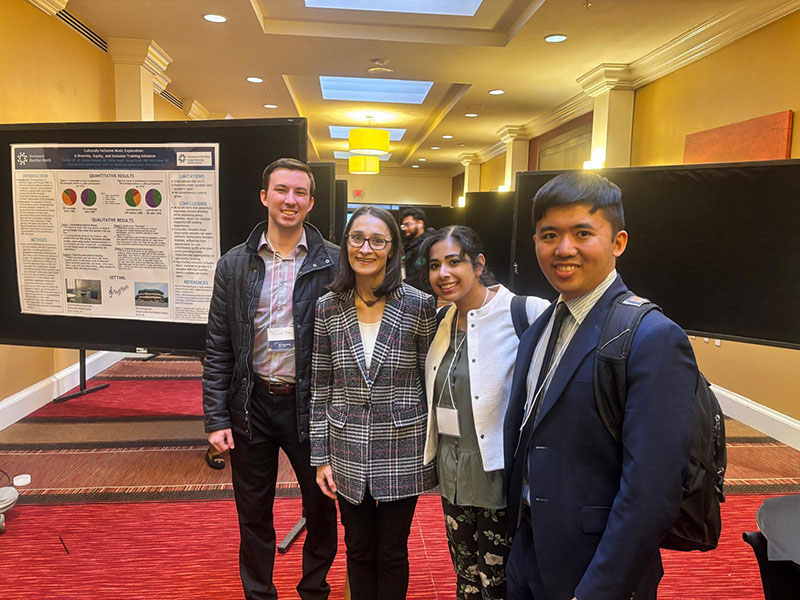This past April, I attended the biannual meeting of the Group for the Advancement of Psychiatry (GAP) in White Plains, NY. The think tank hosted psychiatrists from across North America to develop writing projects on issues faced by our profession. The conference provided valuable networking opportunities and compelling programming, including a presentation by psychiatrist-author Dr. Jonathan Metzl on gun violence and mental health. My co-attendees ranged from GAP Fellows completing clinical training to residency program directors and national organizational leaders.
The conference more than exceeded my expectations. It easily fulfilled why I had applied to join as a GAP Fellow: to contribute my voice to addressing societal problems relevant to psychiatry, and connect with other passionate trainees and mentors. Among GAP’s numerous subspecialty committees, I was assigned to the Work & Organizations Committee, an excellent fit. I found the team welcoming, engaged, and highly experientially impressive; colleagues’ insights derived from extensive consulting and evaluation for institutions such as Harvard Business School and the Boston Police Department. Our brainstorming centered on how psychiatric insights can improve organizations’ efficiency, efficacy, and accountability. We finished the fruitful meeting with project ideas for the months ahead. Examples included developing teaching materials for business clients and examining recent societal shifts in trust among Americans.
As both an APAF Leadership Fellow and GAP Fellow, I saw familiar faces from APA at the plenary and networking sessions. Some included our CEO and Medical Director, Dr. Marketa Wills, and representatives of the APA Assembly and Board of Trustees. Multiple former APA presidents, some of whom also had been GAP presidents, showed up too. Observing the unmistakable overlap between our two organizations, I asked leaders for their thoughts as to GAP’s role in relation to APA and psychiatry. To this, Dr. Steven Sharfstein, former APA president (2005-2006) and former GAP president (2014-2016), summed up for me: “GAP, which was founded by APA leaders in 1946, continues to be the vanguard of psychiatry and its relationships within the profession and outside with society and public health.”
I was invited to read “The Story of GAP,” a history written by Albert Deutsch in 1959, which details the deeply shared roots between APA and GAP. The latter’s founders were APA members who felt that military psychiatrists were under-resourced during World War II. They became inspired to create a smaller, outspoken, and societal change-driven think tank of psychiatrists. This led to their creating the first of many practically oriented “GAP reports,” with titles such as “Psychiatric Aspects of School Desegregation” and “The Person with Epilepsy at Work.” As its founders intended, while retaining its think tank role, GAP reconciled with APA and became its inspirational, leadership-building complement. The two organizations have since invited and exchanged leadership candidates between each other, dating back to GAP founder William Menninger’s 1949 ascension to the APA presidency, and followed by many other shared presidents over the decades. Moreover, like APA, GAP strove to recruit and further the professional development of psychiatry trainees, which culminated in the founding of the GAP Fellowship in 1957.
With these insights, I found my GAP meeting experience fascinating, useful for learning about the history and politics of psychiatry, and rewarding. Given how organically intertwined the two organizations are, I realized that by simply getting more involved in APA, one would almost inevitably connect with leaders having ties in both APA and GAP.

Richard Zhang, M.D. (right), giving a presentation with three of his colleagues in the APA Foundation Fellowships program.
What You Can Do to Get Involved
- Attend the 2025 APA Annual Meeting. Join us in LA! The APA Annual Meeting offers outstanding opportunities to connect with advocates, leaders, and experts across psychiatry, many of whom have ties in both APA and other organizations.
- Consider applying for the GAP Fellowship. Traditionally, every two years, the GAP Fellowship has invited applications from psychiatry trainees nationwide for its two-year fellowship, with the next application cycle planned to open up in Fall 2026.
- Consider applying for an APA Foundation Fellowship. If you are a psychiatry trainee in a residency or fellowship program or an early-career psychiatrist, this experience can connect you with passionate colleagues and mentors involved in not only APA but also other professional organizations.
Taking these steps can grow your career and help shape the future of mental health care. Don’t miss out!
Richard Zhang, M.D., M.A., is a first-year APAF Leadership Fellow completing his child and adolescent psychiatry fellowship at Yale Child Study Center in New Haven, CT.
